Blooming jellies
Jellyfish and other gooey marine creatures are showing up in new places, and scientists are trying to discover why.
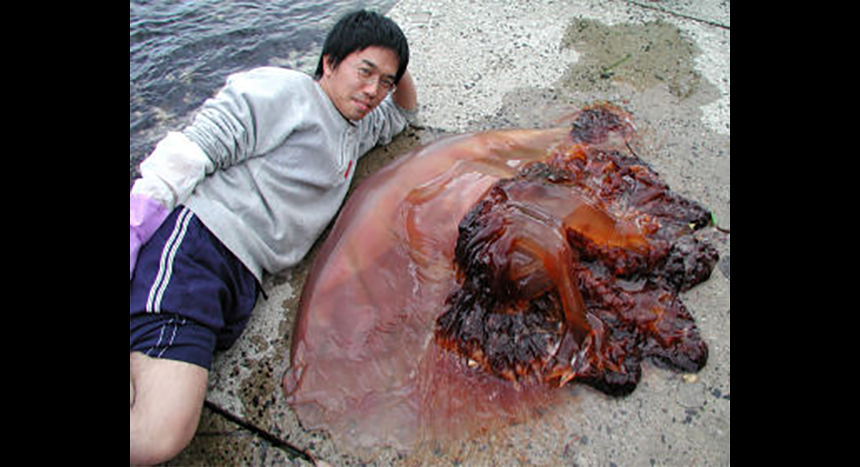
The giant jellyfish can weigh as much as a grizzly bear. Since most people don't like to eat the giant jellyfish (it isn't crunchy enough), its presence is causing lots of problems for fishermen. One of the scientists studying the giant jellies in Japan lies next to the specimen.
Masato Kawahara
Forget snowball fights. Imagine throwing globs of jellyfish at your friends. In some Middle Eastern countries kids have been known to toss jellyfish bits at each other when the gooey creatures wash up on the beach. Like an icy snowball, touching a jellyfish can numb your skin. The numbness comes from special stinging cells. Jellyfish use these stinging cells to stun their dinner or defend against attackers.
A jellyfish’s stinging cells can give you a rash and can even make you very sick. But usually the creatures won’t attack you. “You just need to be careful around them,” says Jennifer Purcell of the Shannon Point Marine Center in Anacortes, Wash. Purcell has been studying jellies for 30 years.
“I have never been afraid of them,” she says. “I treat them with respect, and if I am going to be around them I wear gloves or some kind of covering.”
Purcell even has a favorite kind of jelly: the baseball-sized crystal jellyfish Aequorea victoria. When this graceful, almost transparent creature is disturbed, it glows along the inner edges of its umbrella-shaped body. “It looks like it has bicycle spokes radiating out,” says Purcell.
But crystal jellies aren’t the only ones that intrigue Purcell and other scientists. In recent years, massive groups of different jellies have started appearing in places that don’t usually have so many. And they aren’t always welcome. Jellyfish are clogging pipes that bring water into power plants. Big floating clumps of the animals are getting caught in fishing nets. These jellyfish sometimes kill the fish that have been caught and damage the nets.
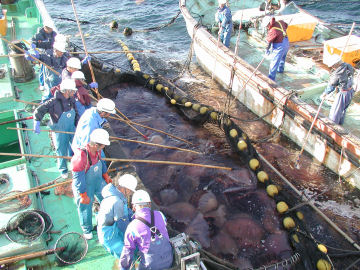 |
|
Fishermen use bamboo poles to push giant jellyfish out of a net. Normally, a fisherman might catch one or two giant jellyfish in a week, but during “bloom” years he may catch more than 1,000 in one net.
|
| Masato Kawahara |
Fishermen worry about these huge groups of jellies showing up in new places. Such a swarm of jellyfish causes problems for the fishermen, who sometimes have to stop fishing for days and may get stung while cleaning their nets.
The changes in jellyfish habits are also worrying scientists like Purcell. They have a lot of questions about what is causing these jelly swarms. Has something changed in the oceans? What effect will the jellies have on fish and other marine life? Will we keep seeing more and more jellies in new places? Or is this just a temporary change that is part of a larger cycle of wind and weather?
Giant jellies in Japan
One jelly that has been a problem for fishermen is the giant jellyfish (Nemopilema nomurai). It is usually found in waters off of Japan and southeastern China. The giant jellyfish is one of the largest; it can grow up to 2 meters across (about 6 and a half feet) and can weigh as much as a grizzly bear (more than 500 pounds)!
The giant jellyfish is usually found in small numbers, but in recent years there have been “blooms” of this jelly—thousands of them crammed together in one place. When the population size of a critter grows so quickly, scientists uaually look at the environment to see if something changed that made it easier for the critter to live there.
Jelly growth
Swarms of giant jellyfish bloomed in Japanese waters in 2002, 2003, and 2004. Afterward, Masato Kawahara from the Oki Marine Biological Station and other scientists in Japan started to investigate the gelatinous beast. The researchers collected its eggs and grew them into jellies in their lab. They paid special attention to how fast the jellies grew in different water temperatures.
Kawahara learned that when the water suddenly got warmer, it caused a change in the jellyfish lifecycle.
Normally, tiny young jellyfish spend their early lives anchored to a rock or the bottom of the ocean. At this stage, they look like little shrubs with tentacles. Then they mature into the more familiar free-floating critters. The Japanese team found that a spike in water temperature caused the young jellies to grow faster. It also triggered a sooner change from anchored jellies to free-floating jellies.
The team also looked at the water currents around Korea, China, and Japan. They think the giant jellyfish babies are born close to the coast. Later, a powerful flow of warm water known as the Tsushima Current carries the baby jellies more than 2,500 kilometers (about 1,500 miles) into the Sea of Japan. That’s a long way—roughly equal to the distance from New York to Colorado.
This current has strengthened in recent years. It usually helps fishermen by bringing a lot of fish, such as horse mackerel. Now fishermen and scientists are watching and waiting to see if the currents will bring more jellies than fish.
Hungry jellies
Off the coast of Alaska, another group of researchers looked at populations of the jellyfish Chrysaora melanaster in the Bering Sea. The UFO-shaped body of these jellies often has a pinkish-orange glow and long tentacles that can stream 5.5 meters (about 18 feet) behind them.
Scientists and fishermen who were working in the Bering Sea in the 1990s were seeing a lot of these jellies, so they decided to do an official count and see what the jellies were eating. Led by Richard Brodeur of the Northwest Fisheries Science Center in Oregon, the team surveyed different sections of the waters. They used trawls, which are large nets towed behind boats. Trawls scoop up everything in their path. After counting jellyfish picked up by the trawls, the scientists examined what was in the jellies’ stomachs.
It turns out the jellyfish ate a lot of little plankton. These are microscopic marine critters and plants that many fish also eat. The jellies ate some baby pollack too. This fish used to be plentiful in the Bering Sea. Pollack grow to about 60 centimeters (around 2 feet) long, and are an important food fish. They are often the fish in fish sticks and fish sandwiches at fast-food restaurants). But the scientists also found that when the pollack got a little bigger, they used the jellyfish for shelter! The jellies protected the young fish from birds, fish, and other animals that might eat them.
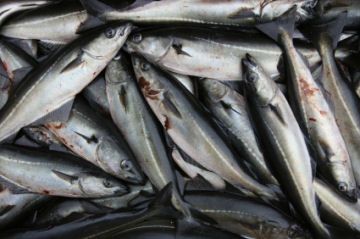 |
|
A large catch of Pollack fish.
|
| iStockphoto |
Then, in 2000, many fewer jellies showed up in the Bering Sea, Brodeur says. The drop is “probably caused by the drop in plankton production,” he says. Brodeur thinks that as the Bering Sea has warmed, there are fewer plankton for the jellies to eat. That may be why there are fewer jellies now. No one knows what that means for the pollack.
Jelly-tons
Scientists are also keeping an eye on creatures known as comb jellies. Distant cousins to the true jellyfish, comb jellies don’t have stinging cells. Instead they make special sticky cells that help them catch food.
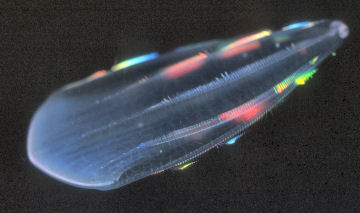 |
|
Comb jellies, like Beroe forskalii, move by waving hair-like projections in their “combs” which stretch between their mouth and anus. Although sponges are generally considered to be the first multicellular animals, new evidence indicates that comb jellies might be even more ancient, scientists report.
|
| Steve Haddock |
One species of comb jelly, Mnemiopsis leidyi (pronounced NEE-mee-OP-sis), is a native of coastal waters from Massachusetts to Argentina. In the 1980s it invaded the Black Sea, a large inland sea between Turkey and Europe. The population of Mnemiopsis grew and grew. By 1989, researchers estimated that the weight of all these comb jellies in the Black Sea was 1 billion tons; that’s about equal to the weight of all the fish caught in all the oceans that year.
Again, fishermen were worried. There were about 400 comb jellies per cubic meter (that’s like 200 golf ball–sized jellies in a space as big as a bathtub). After the comb jellies arrived, the anchovies—a slender, silver saltwater fish—almost disappeared. At first scientists thought the comb jellies were eating the anchovies. But Purcell says the comb jellies are probably eating lots of the anchovies’ food, not the fish themselves. This comb jelly has since spread again. Today it can be found in the waters off Norway and in the Mediterranean Sea.
Jellies in the Web of Life
Purcell recently reviewed several studies that looked into the changing jelly populations. Some of the studies linked warmer waters to the expanding populations. But it is important to remember that warmer waters affect everything in the food web, not just jellies, she says. An especially warm springtime leads to warmer ocean water temperatures. This means the tiny plants and animals that make up plankton grow faster. That’s good for critters that eat plankton.
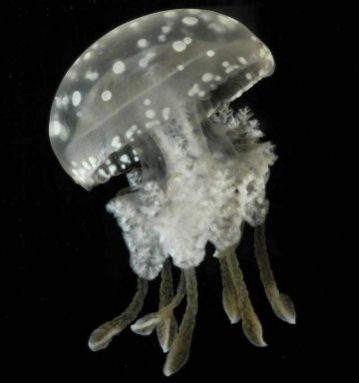 |
|
The spotted jelly, also known as the lagoon jelly because it likes to live in harbors and lagoons, has many little mouths on its oral arms. Small fish sometimes live inside the bells of large spotted jellies, where they are protected from predators.
|
| Alvaro Migotto |
“A warm spring can be good all around for the jellies,” Purcell says.
Purcell also points out that jellies play an important role in the oceans. Turtles and many fish, like the chum salmon, eat jellyfish. Jellies are also food for humans. In China, farms have been set up to grow the edible jelly Rhopilema esculenta, which is enjoyed as an appetizer with salad greens and vinegar. (Once they are cooked “jellyfish have no taste, just crunch,” says Kawahara, who studies the giant jellyfish in Japan.)
In her new study, Purcell points out that humans are changing the environment in many ways that might lead to more jellyfish. More and more power plants are being built, which often warm the waters nearby. More fish farms are being built, which can add a lot of nutrients to waters. This can lead to more plankton and more food for jellies. There may be fewer jellyfish in places like the Bering Sea, but there now may be more in other parts of the oceans.
Today, scientists still have more questions than answers about what is causing the changes in jellyfish numbers around the world. But through careful studies, researchers hope to find out more about the jellyfish blooms and what the blooms can tell us about the health of the oceans.
Jelly vs. jellyfish: What’s the difference?
All jellyfish are considered jellies, but not all jellies are jellyfish. What gives? It turns out that having a body made of jelly doesn’t necessarily mean you are a jellyfish. For example, the animals known as comb jellies look in many ways like true jellyfish, but are actually distant cousins. Comb jellies have different bodies than true jellyfish and don’t make the stinging cells that jellyfish do. These stinging cells are called nematocysts (neh MAT oh sistz).
Scientists are still trying to figure out a lot about the sea’s gooey creatures, and the different kinds of jellies can be hard to tell apart. The true jellyfish are called scyphozoans (sigh-fuh-ZOH-unz) and are a kind of jelly. Then there are two groups of close relatives—box jellies and hydrozoans (HIGH-druh-ZOH-unz). While they are very close relatives of the true jellyfish and they have the same stinging cells, scientists don’t consider them true jellyfish.
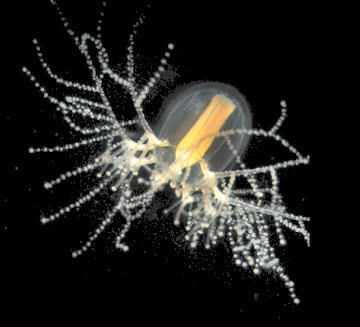 |
|
The small but fast Cladonema pacifica is a hydrozoan.
|
| Alvaro Migotto |
Jellyfish and their relatives the box jellies and hydrozoans are very simple animals. They don’t have brains or hearts or lungs. But they do have a thin layer of muscle. They swim by squeezing this muscle, which forces water out the bottom of their bell, propelling them forward. Scientists think that jellyfish were the first animals on earth to use their muscles to swim.
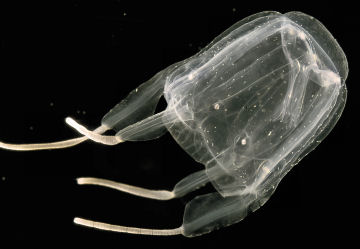 |
|
The four-tentacled box jelly lives in waters around Australia, Malaysia and Japan. Also known as the jimble or sea wasp, its sting is quite painful. Although box jellies are not true jellyfish, they are very close relatives.
|
|
Alvaro Migotto
|
Most small jellyfish eat plankton and floating bits of food. Larger ones will eat fish and other small animals that they stun or kill with their stinging cells. Then they bring food to their mouths with tentacle-like structures called oral arms. Many jellyfish will glow when they are bumped or disturbed. They make a special protein that gives off light.







